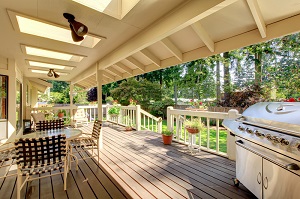Report Overview
Featuring 46 tables and 27 figures – now available in Excel and Powerpoint! Learn More

US demand for outdoor cooking equipment and related accessories is expected to decline on average 3.8% per year from a high 2021 base to $4.4 billion in 2026. Sales surged in 2020 and 2021 as consumers and businesses invested heavily in outdoor spaces because of the COVID-19 pandemic; consequently, the growth outlook will be subdued as the market returns to more sustainable levels. However, several trends will help maintain sales at levels above historical norms, including:
- continuing movement among consumers toward higher value products such as gas, pellet, and kamado grills
- rising ownership of multiple pieces of outdoor cooking equipment to broaden the range of cooking methods users can employ outdoors
- product development, particularly to make the outdoor cooking experience easier and more approachable for novices (e.g., Wi-Fi connectivity, combo grills)
- a greater emphasis placed on cooking at home and better use of outdoor areas for consumers in the post-COVID world
Outdoor Cooking Is More Elaborate & Brings More Indoor Quality Outside the Home
The consumer market drives sales of outdoor cooking equipment, accounting for about 90% of outdoor cooking products demand in any given year. As the outdoor spaces of homes have become more elaborate, the incorporation of multiple pieces of cooking equipment – such as smokers, ovens, and fryers – in addition to grills has become more prevalent. High consumer interest in outdoor kitchens – which typically feature one or more cooking elements – promotes investment in these units to expand the culinary versatility of these spaces.
In addition, these spaces are being outfitted with more indoor-like qualities to provide enhanced functionality and offer more seamless transitions between indoor kitchens and outdoor cooking areas. These trends support not only more intensive use of outdoor cooking equipment per household but also purchase of higher value products with improved aesthetics.
Outdoor Cooking Equipment Is Becoming Easier to Use & More Connected
Newly released outdoor cooking equipment features state-of-the-art cooking control and connectivity. Consumers can connect to and control outdoor cooking equipment from their phones or voice-activated speakers. Grills can be programmed to cook certain foods – a feature that takes stress out of the process of cooking and facilitates entertaining. Not only are these products higher value, boosting sales levels, they are more approachable to novice grillers who are otherwise hesitant to use outdoor cooking equipment. Products that help users better control cooking temperatures can make grilling more similar to indoor cooking methods, with which many people are more experienced.
Outdoor Living & Outdoor Kitchens
While consumers have always enjoyed various outdoor activities, the concept of outdoor living (e.g., entertaining, dining, and cooking outdoors) has evolved in the last decade. Increasingly, outdoor living means furnishing outdoor spaces with more than a simple patio and grilling set, but with a number of amenities, including cooking appliances. Increasingly, it means outfitting outdoor spaces with high-quality grills and outdoor kitchen appliances to match the style and functionality of indoor spaces. Thus, outdoor living continues to drive new sales of outdoor cooking equipment.
During the COVID-19 pandemic, interest in outdoor living surged as consumer lifestyles changed. Since they were cooking more often at home (in addition to using their outdoor spaces more frequently), consumers invested in outdoor cooking equipment upgrades and additions of multiple cooking units – particularly types that allow for a variety of cooking methods – to broaden their culinary capabilities. Outdoor kitchen installations also grew during the pandemic as consumers sought to enhance the utility and style of outdoor cooking areas:
- Popular purchases for these projects include high-end grills – usually built-in natural gas or propane types – and other cooking surfaces.
- Consumers are also increasingly adding in cooking fixtures that can enhance flavor, such as a kamado grill.
Home renovation spending is expected to remain elevated compared to the pre-pandemic era and will continue to boost outdoor cooking product sales over the next several years. In particular, projects involving installation or expansion of outdoor kitchens will promote sales, as these projects often entail purchase of grills in addition to equipment like fryers, ovens, and smokers (in more elaborate spaces):
- Homeowners with outdoor kitchens are generally more willing and able to invest in high-end models with value-added features and finishes that imitate the look of indoor appliances.
- While the large number of outdoor kitchens installed during the pandemic will limit the number of installations going forward, sales opportunities exist among homeowners looking to add more units to expand the culinary capabilities of their outdoor kitchens or to upgrade to higher value models.
In addition to cooking, dining, and entertaining guests, outdoor cooking features can supplement a number of outdoor living activities, including:
These activities are also important to the outdoor cooking products industry, as participants generally own and regularly purchase additional or upgraded portable grills and other cooking equipment like smokers.
In addition, participation in other outdoor-specific activities, both at and away from home, can indicate interest in outdoor cooking. For example, at-home activities such as gardening and landscaping involve spending significant recreational time outdoors. These activities are also important indicators of demand because consumers who enjoy these activities are likely to make further use of their outdoor spaces by purchasing stylish and feature-filled outdoor cooking equipment.